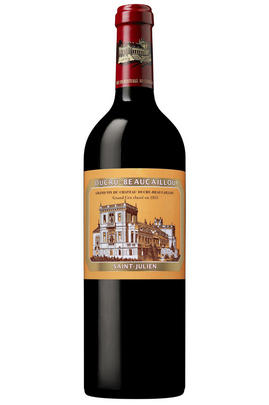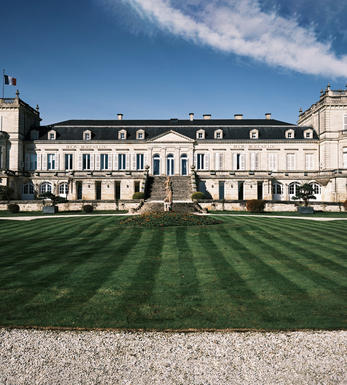
2022 Château Ducru-Beaucaillou, St Julien, Bordeaux

Critics reviews
The 2022 Ducru-Beaucaillou contains less Cabernet than last year and is closer to the normal blend of the Grand Vin, picked between 7 September and 4 October - the most extended harvest in their history. The IPT is 95.
Matured in 100% new oak, the bouquet bides its time in the glass, almost reluctantly unfurling with scents of blackberry, briary, cigar humidor and sous-bois. At this nascent stage, it is more backward than its peers. The palate is undoubtedly one of the most dense and muscular I have encountered over many years, tasting at the estate, full-bodied with vice-like tannins.
Continuing the theme of the estate's other cuvées, there is a lovely Pauillac-like presence throughout, with graphite/pencil lead infusing the black fruit. The finish exerts a considerable grip and feels saline, almost briny on the aftertaste. This Leviathan Ducru-Beaucaillou threatens to overwhelm the senses, uncompromising in many ways, and it will patently take many years for the tannins to soften.
I feel that it is only once in bottle that one can gauge its trajectory.
Drink 2040 - 2075
Neal Martin, Vinous.com (April 2023)
The 2022 Ducru-Beaucaillou is elegant and nuanced. Bright red/purplish fruit, rose petals, blood orange, mint, and spice give the 2022 unusual brilliance. In most recent vintages, Ducru has been on the opulent side.
The 2022, conversely, is strict and linear in construction, a wine that is more about persistence than size. Bright saline underpinnings extend the mid-palate into the striking, beaming finish.
Harvest took place over four weeks, the longest ever, as opposed to the two weeks or so that is the norm. Yields were 30hL per hectare, down from the 35-37 typical in recent years.
Drink 2032 - 2052
Antonio Galloni, Vinous.com (April 2023)
Deep damson colour, poised and intense, a serious wine with crushed mint, graphite and bitter black chocolate on the opening beats, setting the tone for a slow reveal of the confident St Julien character. Powerful tannins convey purity and precision, set against creamy cassis and bilberry fruits, with softer smoked earth, baked spice, and a slate finish.
The construction is careful and measured, extremely impressive; this has decades ahead. 3.8ph, 95IPT. 100% new oak. 30hl/h yield.
Drink 2032 - 2050
Jane Anson, JaneAnson.com (May 2023)
82% Cabernet Sauvignon, 18% Merlot. Cask sample.
Deep colour – purple-black to the rim. Cassis and blueberry fragrance with a toasted oak edge. Smoky and minerally as well. Smooth texture with a generous quantity of tannin behind. Concentrated, polished and long. It has the potential but needs time.
Drink 2034 - 2055
James Lawther MW, JancisRobinson.com (May 2023)
One of the Médoc's most powerful wines this year is the 2022 Ducru-Beaucaillou, a blend of 82% Cabernet Sauvignon and 18% Merlot that opens in the glass with aromas of dark cherries and berries mingled with pencils shavings vanilla pod and spices.
Full-bodied, broad-shouldered and muscular, with a core of ripe but lively fruit underpinned by a chassis of powdery, liberally extracted tannin that asserts itself on the finish, it's a punchy, modern Saint-Julien reminiscent of a hypothetical blend of the 2018 and 2020.
William Kelley, Wine Advocate (April 2023)
Some much creme de cassis and blackcurrant aromas and flavours here. Full-bodied with powerful tannins, yet fine and layered. Chewy. You can really feel the thick grape skins here. Excellent length. Tannins spread across the palate. Minerally and crushed stone.
James Suckling, JamesSuckling.com (April 2023)
Beautiful and beguiling nose, perfumed blackcurrants and dark fruits; damsons, plums, raspberries and rose petals. Lovely crunchy fruit, a real bite, and presence in the mouth. Excellent precision, tannins are succulent and ripe; they fill the mouth with a juicy, intense granular texture.
There is such depth to this - perfume, tobacco, earth, violets and concentrated fruits with a verticality, with an unprecedented 98% of Cabernet Sauvignon providing the support and the backbone. The fruit’s crystalline purity makes the frame tense; it’s focused and driven, all with excellent definitions.
This is not a wallflower of wine - it’s charming and confident, strutting its stuff right now and giving you absolute St-Julien terroir and vintage markers in the glass with slate, graphite and liquorice salinity on show.
Skilled winemaking on show.
Drink 2030 - 2050
Georgina Hindle, Decanter.com (April 2023)
Moving to the Grand Vin, it's a slightly more Merlot-influenced blend of 82% Cabernet Sauvignon and 18% Merlot, raised in new barrels. It brings the same level of concentration and structure as the La Croix but has another level of class, elegance, and purity, with sensational aromatics of crème de cassis, graphite, crushed stone, sandalwood, and graphite.
The purity here is truly remarkable, and it hits the palate with full-bodied richness, perfectly integrated oak, silky tannins, and a great finish. This beauty hit 14% natural alcohol with a pH of 3.8 and an IPT of 95. Given its balance and texture, it will offer pleasure with just short-term cellaring yet also evolves for decades.
Jeb Dunnuck, JebDunnuck.com (May 2023)
About this WINE

Chateau Ducru-Beaucaillou
Château Ducru-Beaucaillou is a St-Julien property that today is one of the leading Super Seconds. It is owned by the Borie family and is situated in the south-east of the St-Julien appellation. Ducru-Beaucaillou's 50 hectares of vineyards (Cabernet Sauvignon 65%, Merlot 25%, Cabernet Franc 5% and Petit Verdot 5%) lie on deep, large-stone gravel beds enriched with alluvial soil deposits and with a high clay content. The wines are matured in oak barriques (50-60% new) for 18 months.
For many, Ducru-Beaucaillou is the quintessential St-Julien - deep-coloured, powerful, ripe, exquisitely well-balanced and perfectly harmonious. It requires a minimum of 10 years of bottle ageing before it should be approached and the best vintages will continue improving for many more years. Ducru-Beaucaillou is classified as a 2ème Cru Classé.

St Julien
St Julien is the smallest of the "Big Four" Médoc communes. Although, without any First Growths, St Julien is recognised to be the most consistent of the main communes, with several châteaux turning out impressive wines year after year.
St Julien itself is much more of a village than Pauillac and almost all of the notable properties lie to its south. Its most northerly château is Ch. Léoville Las Cases (whose vineyards actually adjoin those of Latour in Pauillac) but, further south, suitable vineyard land gives way to arable farming and livestock until the Margaux appellation is reached.
The soil is gravelly and finer than that of Pauillac, and without the iron content which gives Pauillac its stature. The homogeneous soils in the vineyards (which extend over a relatively small area of just over 700 hectares) give the commune a unified character.
The wines can be assessed as much by texture as flavour, and there is a sleek, wholesome character to the best. Elegance, harmony and perfect balance and weight, with hints of cassis and cedar, are what epitomise classic St Julien wines. At their very best they combine Margaux’s elegance and refinement with Pauillac’s power and substance.
Ch. Léoville Las Cases produces arguably the most sought-after St Julien, and in any reassessment of the 1855 Classification it would almost certainly warrant being elevated to First Growth status.
Recommended Châteaux: Ch. Léoville Las Cases, Ch.Léoville Barton, Ch Léoville Poyferré, Ch. Ducru-Beaucaillou, Ch Langoa Barton, Ch Gruaud Larose, Ch. Branaire-Ducru, Ch. Beychevelle

Cabernet Sauvignon Blend
Cabernet Sauvignon lends itself particularly well in blends with Merlot. This is actually the archetypal Bordeaux blend, though in different proportions in the sub-regions and sometimes topped up with Cabernet Franc, Malbec, and Petit Verdot.
In the Médoc and Graves the percentage of Cabernet Sauvignon in the blend can range from 95% (Mouton-Rothschild) to as low as 40%. It is particularly suited to the dry, warm, free- draining, gravel-rich soils and is responsible for the redolent cassis characteristics as well as the depth of colour, tannic structure and pronounced acidity of Médoc wines. However 100% Cabernet Sauvignon wines can be slightly hollow-tasting in the middle palate and Merlot with its generous, fleshy fruit flavours acts as a perfect foil by filling in this cavity.
In St-Emilion and Pomerol, the blends are Merlot dominated as Cabernet Sauvignon can struggle to ripen there - when it is included, it adds structure and body to the wine. Sassicaia is the most famous Bordeaux blend in Italy and has spawned many imitations, whereby the blend is now firmly established in the New World and particularly in California and Australia.


Buying options
Add to wishlist
Description
This wine practically overwhelms the senses, such is its density and power. The bouquet is intense and thickly perfumed, the palate immense with deep, dark textures and flavours. The velour is immaculate and seamless, with nothing out of place. The bouquet is direct, pure and heady, with blackberry and peony.
The palate is fruit accented, with less spice or earthy notes, although there is a glint of graphite and a suggestion of oyster shell. The wine cannot help but give pleasure as your senses acclimatise themselves to its ebullient charms.
Cabernet Sauvignon 82%; Merlot 18%
Drink 2032 - 2060
Score: 18/20
Berry Bros. & Rudd (April 2023)
wine at a glance
Delivery and quality guarantee